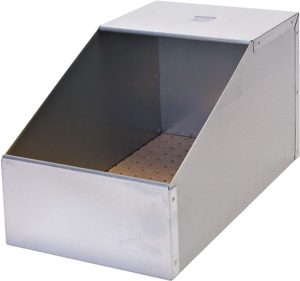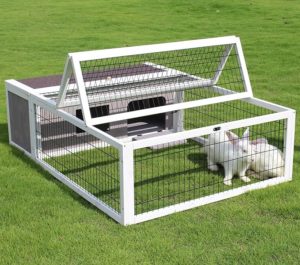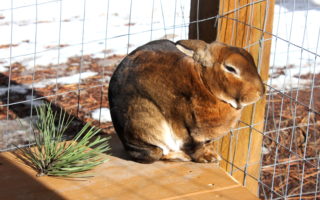Raising meat rabbits can be fun to raise if you have kids that do 4-H or just are learning responsibility of caring for an animal. They can provide your family and or dogs a food source with 2 does to 1 buck providing you with roughly 180 lbs of meat per year. You can show them and or sell them for an income. Or if you have a crafty side, they can also provide you with fur pelts to make pillows or throws.
They are also one of the easiest to raise for meat for several reasons. They are easier to process and clean verses chickens with all those feathers. They are easier to store vs if you process a bigger animal, you may not have the space for all that meat. And they breed and grow quickly, making for a quick turn around on your investment.

Meat Breeds & Genetics
We personally like to raise Standard rex rabbits for the plush velvet fur and for their meat. New Zealands and Californians are some of the most popular breeds for quick growth, large litters, and large carcass. Other varieties include American Chinchilla, Silver Fox, Champagne D Argent, Cinnamon, Satin, Palomino. Flemish Giants are considered meat rabbits, and though they do get large, they can take much longer to reach butcher weight than other breeds and may not be worth the cost of feeding vs meat.
Another thing to consider when you’re choosing your stock is good genetics. Look for rabbits whose parents produced large fast-growing litters to give you a quick turn around on your investment.
What You’ll Need
The basic set up includes . . .
–Cages that are a least 2′ X 3′
–Water bowl or bottles
Feeding
Each rabbitry comes up with their own way of feeding their rabbits, but pellets are commonly used for a good portion of the diet along with some hay. On our farm, we like to feed an alfalfa/grass mix hay during the active breeding season for pregnant does, nursing does, and baby kits, and then plain old grass/timothy hay for bucks or non-breeding rabbits. In addition, we feed 1/2 cup of pellets (1 cup for does that have given birth, and unlimited for babies). On and off I grow sprouts for the rabbits, mainly during the breeding season for the nutritional boost. If we can, we also provide a daily serving of vegetables if not every other day. You can see what vegetables and fruits we feed on my other blog post “Feeding Rabbits Fruits & Veggies“.
To Recap What We Feed . . .
Alfalfa/Grass Hay: Unlimited Amount For Breeding Does & Babies
Alfalfa: Unlimited For Bucks & Non-Breeding Does
Pellets: Bucks/Non-Pregnant Does = 1/2 cup
Does Near Birthing Or Nursing Kits = 1-2 cups
Kits = Unlimited
Sprouts/Fodder: 1/2 – 1 cup per rabbit
Veggies: Daily To Every Other Day
Fruit: 1-2 Servings Per Week
Breeding Age
Females: (6-8 months) You want your does to be full grown and physically ready for breeding before starting to have litters. Depending on how fast your rabbit has grown you will want to wait until 6-8 months to begin breeding your doe for the first time. I prefer to wait until closer to 8 months to ensure they are full size and ready to go.
Males: (8-10 months) Now you may be wondering why the males need to be older. Bucks can technically breed as early as 4 month old, BUT, if they’re too young and inexperienced they may get their butts whooped by the doe you’re trying to breed him with. If he gets beaten up at a young age, he may not be as eager about breeding in the future.

Breeding Problems & Solutions
Every breeder encounters problems with breeding whether it be due to time of year, temperatures, or a stubborn doe. A big thing to remember is that rabbits are territorial, therefore you want to be sure to put your doe into the buck’s cage, not the other way around. The doe is more willing to breed if she’s in unfamiliar territory and the buck is ready to go. You’ll know a doe is bred when the buck “falls off”. If he missed, he’ll try again immediately after.
Winter: Here in Colorado, we’ve found that the rabbits will not breed during winter (about a 5 month span). For good reason, IT’S COLD! They main reason is due to the decrease in light. Most rabbits won’t breed until they are getting 12+ hours of daylight per day. We’ve found that our does start accepting the buck as early as mid-February and continue to breed until about September/October. Supplemental lighting can fix this issue, though we prefer the break from raising, feeding, and processing and just wait until mid-February to start up production again.
Summer: We don’t have too big of a problem with Summer because we generally only get as hot as 80-85°F. In hotter climates however, Bucks can temporarily go sterile at anything 80°F and hotter. To solve this, you can try to find a cooler spot for your buck or find ways to keep him cooler. Our buck stays on the ground and therefore are able to keep cooler on the dirt.
Stubborn Doe: Sometimes you’ll run across a stubborn doe who refuses to be bred. There are tricks to get around this, one that worked part of the time for us is putting the doe in a cage, driving her a couple times around the block, and then immediately putting her in with the buck. Personally, we’ve gotten rid of stubborn does, one of which was quite aggressive and would tear fur out of our buck. Something else you can try is placing your doe in a cage next to the buck. This way she has time to get used to him and accept him. I’ve also heard that adding ACV (apple cider vinegar) to their water can encourage breeding (about a tablespoon per gallon).
Gestation & Preparing For Babies
Gestation is generally 30-32 days. Preparing for babies is as simple as putting a nesting box into your does cage a few days before she is due. I put the nesting boxes in more like a week before as my does seem to get antsy without it and try to make a nest where they can. In each nesting box I’ll put a good amount of hay for nesting material and roughly prepare it like mamma rabbit would. Avoid using straw! Straw is dusty and can cause respiratory problems in your rabbits. The doe usually will pull hair from her chest 1-3 days before she gives birth to prepare a soft spot for the upcoming babies.
What About Cold Weather? Even though February sends the signals that spring is on the way and we begin to see litters. We still get snowstorms and cold temperatures. As long as you provide your rabbits adequate dry nesting material and they pull enough fur, their babies should be just fine. We’ve gotten down to 8°F at night when there was a newborn litter. But the next day the babies were just fine, warm and wiggly. Generally, it’s not a problem, but something you can do is save fur from past litters to have on hand just in case one of your does didn’t pull enough fur.
Caring For A Litter
This is pretty hands off as the doe should take care of everything. I pay close attention to see when the babies are born so I can mark it on the calendar, check for any dead ones, and with new does I want to make sure she gave birth in the nesting box. After 1 week I carefully change out the nesting material with fresh hay, being sure to set aside the pulled fur to put back in.
Nest Box Eye: The babies eyes start to open around day 9-10 at which point you’ll want to keep an eye out for “nest box eye”. I tend to wait until day 12 to check to make sure all eyes are open. Nest box eye is an infection of the eye from getting either waste or other material in their eye. Just keeping the eye clean by wiping it with a damp cloth generally takes care of it. You can also make chamomile tea to dampen the cloth with. Not doing anything will likely result in a blind rabbit in the affected eye.
 How To Know If A New Doe Is Caring For Their Litter?
How To Know If A New Doe Is Caring For Their Litter?
If the doe pulled hair for the nest, then she is likely caring for her litter. Rabbits only feed their babies 1-2 times per day, so you are not likely to see her caring for her offspring. In the wild this helps protect the babies by drawing less attention to the nest. A final way of knowing is that those babies aren’t going to last very long otherwise. You’d hope that isn’t the case but your options at that point are to either re-breed the doe and give her another chance to be a good mother, especially if it was her first litter. Or you’ll want to find another doe with better mothering instincts.
When To Wean And Process
Weaning takes place between 6-7 weeks old. Some remove kits a few at a time, others remove the mom from the babies to ease the stress on the babies. We generally remove the babies at about 7-8 weeks old and split the bucks and does into separate cages.
The age to process depends on your breed and genetics. Fast growing rabbit are ready to process at 8-10 weeks of age or at about 5 lbs. Rex rabbits tend to be a little slower growing, so we don’t process babies until more like 12-14 weeks of age. The quicker the turn around the better the return on your investment.
Wait! Don’t meat rabbit get to be more like 10 lbs as an adult? Yes, but rabbits only grow fast for those first few weeks. Waiting too much longer and the babies growth greatly slows down. So, the rabbits end up costing you more money in feed, and not growing much faster.
If you’re raising rabbits for fur, then you’ll want to wait until they mature more like 6 months of age. The longer you wait though, the harder it is to remove the pelt from the carcass.
When To Re-Breed Your Doe
This varies from breeder to breeder. Some have a more aggressive breeding program doing 6-7 litters per year. Others like us try to limit it to more like 3-4 litters per year. A more aggressive breeding program re-breeds the does when their current litter of kits are 2 weeks old. Our initial aim was to re-breed our does a month after the previous litter was weaned. But because our rabbits don’t tend to breed during winter, we needed to breed a little more aggressively for the spring and summer months. So, when litters are 4 weeks old, we re-breed. This gives them (and us) a 4-5 month break during the winter.
When To Retire And Replace A Buck Or Doe
Does 2-4 years: Though the lifespan of a rabbit is more like 9 years. The breeding years for a meat rabbit is much shorter. Birth, especially several times per year, is hard on the body. Breeding much longer than 4 years may result in failed litters, smaller litters, or other problems. Once your does reach that point, you can either process them or find them a home as a pet depending on how much handling you did with them. I prefer to find them a home where they can retire and live out their lives. But not everybody wants and older rabbit.
Bucks 4-5 years: You can try breeding your bucks longer but it’s at about 4-5 years old that their fertility will begin to drop.
Aside from buying new stock. You’ll logically want to replace your breeders with the best of their offspring. You’ll want to pick the fastest growing and then whatever additional qualities you want (color, temperament, conformation for show). Another thing you might want to do before retiring mom completely is make sure her replacement is not stubborn about being bred. Or maybe choose a couple does out of the litter just in case there is a problem with one of them.
How many rabbits do I need to feed my family?
This is based on how much meat your family eats. Say your family will eat 2 rabbits per week. So, 2 rabbits times 4 weeks in a month times 12 months in a year means you will want to produce about 96 rabbits per year. Take those 96 rabbits divided and by the average litter size of 8 equals 12 litters needed. Say you’re only able to get 4 litters per year from each doe means you’ll want to have 3 breeding does and one buck for a total of 4 rabbits. If you’re able to get 6 litters per doe per year, then you only need 2 does and 1 buck.
Hopefully this was helpful as you begin your journey with meat rabbits. Please let me know if you have any questions.









